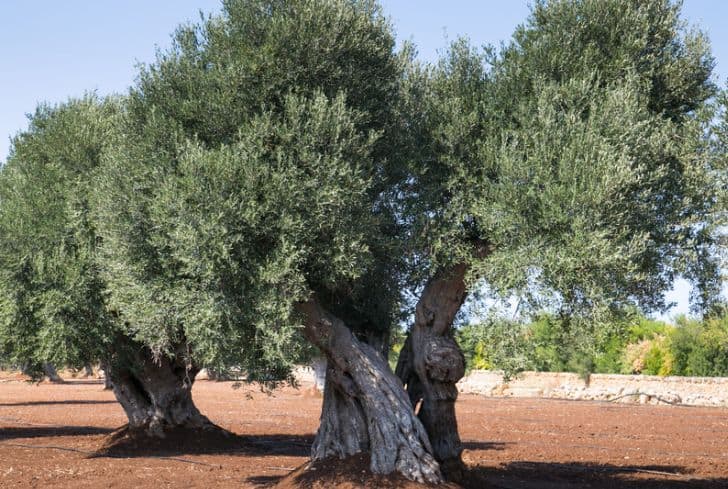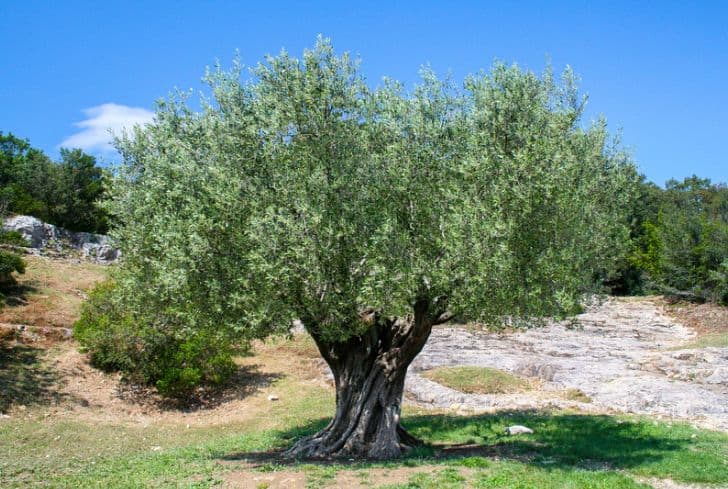A long-standing favorite for southerners in the United States is the fragrant tea olive tree. The glossy-leaved evergreen shrub provides strong bursts of sweet floral fragrances multiple times throughout the year from their tiny white blossoms. Commonly used in containers on patios, as natural fences, or as a way to brighten up any landscape design, tea olive shrubs are iconic. But are tea olive tree roots invasive?
Tea olive tree roots are not invasive. The tree is slowly growing and can easily be contained in pots. When grown in the ground, the tea olive tree reaches a height 6-10 feet tall with a matching spread. Generally, root systems match the spread of the tree so avoid planting your tea olive within 8 feet of your home.
Do Olive Trees Have Invasive Roots?
Deciding to add a tree or plant to your yard requires more knowledge and consideration than just going to a nursery and picking the prettiest one. It’s important to understand the root system of larger trees especially if you will be planting it near your home or other building as roots of different types of trees can cause damage that is both costly and dangerous in the long run.
Olive tree roots are not considered invasive as they tend to only spread three to five feet deep and are incredibly slow growing. However, it’s best to avoid planting an olive tree within 15-20 feet of buildings, homes, sidewalks, or other pavement areas to avoid the possibility of problems as the tree matures in age.
There are over 35 varieties of olive trees each with its own specific and slightly differentiating features including size and shape. Generally, olive tree roots will match the spread of the branches. It’s best to know which type of plant you are growing and how large it will get so you can plan accordingly before planting. Taking the time to understand your olive tree sets you up for many future successes in your garden and landscape.
How Deep are Olive Tree Roots?
Since the root systems of olive trees are considered to be noninvasive, it is safe to plant these. The tree’s roots won’t overtake other plants around it nor damage pipes, sidewalks, or other structure in its path. However, it’s still recommended to plant the tree far enough away for homes to avoid any possible damage as the tree grows larger. The total length of the root system will match the spread of the tree’s branches, but how deep are olive tree roots?
The roots of an average olive tree run between 2-5 feet deep. They are considered to have a shallow root system. The taproot of the olive tree will develop for the first few years of the tree’s life while the lateral roots will continue to grow until the tree reaches its final mature height and width.
The shallow root system of the olive tree is thought to allow the tree to gather as much rainwater and moisture from the topsoil as it trickles down. The taproot of the plant goes straight down into the earth and anchors the tree while also having access to water deeper within the earth’s crust while the lateral roots provide stability for the tree and can access more superficial water.
Can Olive Tree Roots Damage Foundation or Pipes?
Olive trees offer a unique addition to your landscape or garden with the added benefit of enjoying varieties of delicious olives throughout the season. It’s no wonder so many individuals are drawn to the idea of growing an olive tree on their property. But it’s important to discuss if olive tree roots can damage foundations or pipes.
While olive tree roots are considered to be noninvasive thanks to their slow-growing nature, it’s still recommended not to plant your olive tree within 15-20 feet of your home to avoid any possibility of the roots interfering with your home’s pipes or foundation.
It can be risky to plant any tree within close proximity of your home. Even if the roots are slow growing and generally non-aggressive, they can still wrap around pipes or cause damage to your foundation.
Generally, the problem of roots near a foundation come in to play when the roots are pulling all the moisture away from the foundation walls, leaving it dry and brittle and prone to cracking. Any root will draw moisture away from the surrounding soil as a way of self preservation, thus it’s always best to plant your trees at a safe distance from your home.

Do Olive Trees Spread or Multiply?
Hoping to add some new olive trees to your land this year? Whether you have a large lot of land or a small backyard, there is a variety of olive trees that will fit your needs perfectly. When you begin to look for an olive tree, you may wonder do olive trees spread or multiply?
In the wild, olive trees spread and multiply by producing seeds. The tree will flower in the spring, attracting pollinators like butterflies, bees, and other insects. Once the pollinated flower fades, the olive will begin to grow. Birds and other wildlife take the olives and spread them throughout the area, creating new opportunities for olive trees to grow.
When grown by a gardener, new olive trees can be obtained by propagating a current plant or planting new seeds. Propagating olive trees takes much less time and requires minimal effort. The end result is a small, easy-to-plant sapling that will begin producing fruit much sooner than any plant grown from seed.
Growing olive trees from seed is possible but require the right conditions and lots of attention. You may also not get the most favorable outcomes from seeds as it is hard to control the pollination of the original flower.
Generally, if you are looking to purchase an olive tree, going to a local nursery will be the easiest and most efficient way to get your new plant sapling with the assurance that the olive tree will thrive once established.
Can You Plant an Olive Tree Next to a Wall?
Olive trees are Mediterranean. They need environments that mimic where they are native to thrive. Luckily, there are plenty of places within the United States that offer the same sort of climate the olive trees are looking for. One thing that many people don’t consider is that olive trees also like protection. Can you plant an olive tree next to a wall?
Olive trees prefer some level of wind protection. They will thrive in sunny, dry, hot spaces. Generally, planting your olive tree in a south-facing spot with a brick wall to its back will create an environment for your olive tree to thrive.
While planting a row of olive trees against a brick wall running along the property line of your yard will create a serene scene, avoid planting an olive tree too close to any walls of your home or buildings. While the root systems aren’t considered aggressive, roots do pull moisture from the soil surrounding them which can lead to dry, cracked foundations and sagging walls in the future.
How To Keep Olive Trees From Becoming Invasive?
Many people are saddened to learn that the beloved olive tree is considered to be an invasive species in California and other places. While not every species of olive tree is as invasive as others, it’s important to consider the repercussions on the ecosystem planting an olive tree may have. If you already have an olive tree on your property, take steps to prevent it from spreading.
Keep your olive tree from becoming invasive by taking care of your trimmings properly, cleaning up any olives on the ground, and removing any olive tree that is considered dangerous to the ecosystem.
Olive trees can spread through propagation, so be mindful when trimming the branches of your tree. Never leave the cuttings on the ground near fertile soil as they can root and grow easily.
The other way that olive trees spread is through the seeds in their fruit—olives. Picking up any fruit left on the ground and plucking fruit on the trees before they fall can help stop the spread of olive trees.
If you notice that your olive tree is spreading quickly or is taking over other native plants, it may be best to remove your olive tree. While you can use herbicides to kill the smaller trees, larger trees may need to be dug out and removed professionally.
How To Care For Olive Trees
Olive trees are considered to be low maintenance once they are established. Whether you are growing your olive tree in the ground or in a pot, their basic needs are the same.
Olive trees thrive in hot, dry, and sunny locations. They need well-draining soil and heavy watering, especially when they are young and during the summer months. Installing an irrigation system may help keep the olive tree happy and watered. Prune the tree back as needed, taking care to place the cuttings in a safe space.
If you are growing your olive tree in a pot, be sure to repot as the tree grows as the roots will need plenty of space to spread. Olive trees grown in conditions that aren’t ideal may have a hard time producing olives.






